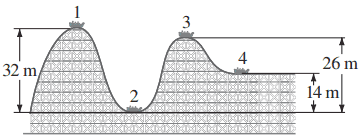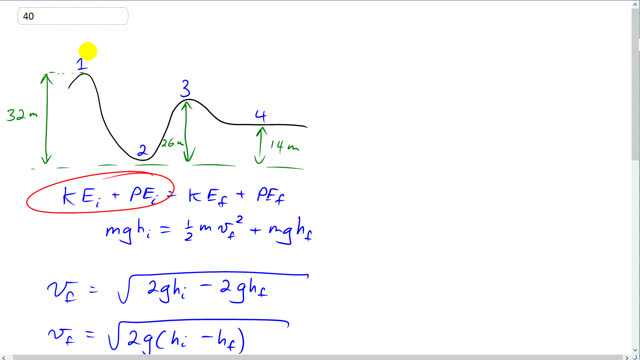
A roller-coaster car shown in Fig. 6–41 is pulled up to point 1 where it is released from rest. Assuming no friction, calculate the speed at points 2, 3, and 4.


In order to watch this solution you need to have a subscription.
This is Giancoli Answers with Mr. Dychko. To calculate the speed of the roller coaster at points 2, 3 and 4, we are going to use conservation of mechanical energy. So we have the initial kinetic and potential energy that the roller coaster has at point 1, is gonna equal the total potential plus kinetic at any other point along its route. assuming there's no friction and so on. Initially, there's no speed so kinetic energy is zero and it has just potential energy, mg h initial, or h is measured above this reference level here, which is at point 2. And then, it will have some final kinetic energy one-half m v final squared plus some final potential energy assuming it's above the reference level, mg h final, height final. And, we can solve this for v f by moving this term to the left side which makes it minus and then cancel out the m's everywhere and multiply everything by 2 so it becomes 2gh f and 2gh i. And then take the square root of both sides to solve for v f. And we can factor out the 2g from both terms there, and we get this formula, v f equals square root 2g times initial height minus final height. So we can use this formula for parts (a), (b) and (c). So for part (a), at position 2, we have 2 times 9.8 meters per second squared times 32 meters—initial height— minus the height at point 2, which is 0, and so we get an answer of 25 meters per second will be its speed at point 2. And then, it'll slow down a bit as it, some of that kinetic energy turns back into gravitational potential energy but there will still be some kinetic energy leftover because point 3 is still some distance below point 1 and it'll result in a speed of square root 2 times 9.8 times 32 meters minus 26 meters and that gives 11 meters per second. And at point 4, it's 14 meters above this reference level and we have square root 2 times 9.8 times 32 meters minus 14 which gives 19 meters per second will be the speed at point 4.
I'm confused. I did the problem, but for each point my initial velocity was obtained from the Final velocity of the previous point. For example, the final velocity I obtained for point 2 was 25m/s, which is correct. But for point 3 I assumed the initial velocity would be the final velocity of point 2 (25m/s) and assumed the initial height = 0 while the final height = 26m. Did the same process for the next point where my Vi=2.4m/s (obtained from Vf of point 3) and my Initial height=12 (subtracted 26 from 14). I thought your point of reference was the lowest point, which I though in point 4 would be 0 and the highest 26-14? Sorry I'm just really confused. Cab you tell me why my process is wrong? Thank you!
Hi p.zepplin, the important thing to be mindful of with conservation of energy questions is to choose one point of reference for the entire question, and don't change that reference point. You can choose any reference point you want, but after making the choice you can't change it.
Just to make this point clear, consider a book on a table top 3m above the floor. If you move it horizontally, the potential energy with respect to the floor doesn't change because its height hasn't changed. However, if you change your reference point to be the table top after moving the book horizontally then it would suggest the potential energy became zero after moving the book horizontally, which is not a correct conclusion and illustrates the problem of changing your reference point during a question.
I usually choose a reference point which is at the lowest since otherwise you'll get a negative potential energy, which I find confusing. The lowest point in this question is point "2". All heights are measured with respect the the reference level at point "2". Take another stab at this problem now that you've read this and let me know how it goes.
Cheers,
Mr. Dychko